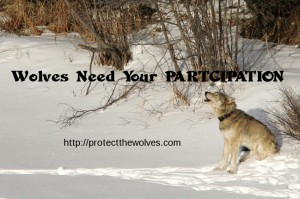
This Article was done 3 years ago…. and yes it still Matters!! They continue to Slaughter Wolves in Every State they currently reside!
After four decades on the federal endangered species list, the gray wolves’ population has officially recovered, according to the U.S. Fish & Wildlife Service. This month, the agency proposed turning over management of the wolves to the states’ wildlife departments—even those states where the canids have yet to show up. The decision is based solely on numbers, and so it misses what is increasingly evident to wildlife biologists and conservationists: the importance of individual animals.
I learned this firsthand during a visit to Yellowstone National Park last winter, where wolf-watchers pointed out to me through their spotting scopes the forlorn figure of a male wolf known to park biologists as755M. He was curled up tightly on a snowy hillside, and lay so still he looked more like a stone or downed log. Most unlike a wolf, he was alone.
Only a few weeks before, 755M had been the alpha male of the Yellowstone’s Lamar Canyon Pack, and mate of the park’s most famous female, 832F. She was world renowned–the “rock star” of wolves some called her—and he was not or, more correctly, is not. He is, after all, still alive, although some might say he’s but a ghost of his former self, because she is gone, felled by a Wyoming hunter’s bullet.
Does the death of one wolf matter? From a purely demographic standpoint, biologists say no. If there are sufficient numbers of wolves to breed, then the species is fine, so the old way of thinking goes. But for 755M and his pack, and for other Yellowstone wolves, the death of 832F has had enormous repercussions, which continue to this day.
People were drawn to 832F because she was an unusual female wolf—saucy, independent, powerful and wily enough to bring down a bull elk alone, and unwilling to be anything other than the leader of her pack. She’d scorned all her suitors until she met a pair of malleable males, the black-and-silver furred brothers, 755M and 754M. They were younger than she was, and were mediocre hunters at best, but the trio formed a pack, which the brothers wisely let her lead. By 2012, they had grown to 13 strong, and were the indisputable rulers of the Lamar River Valley with its herds of elk and buffalo. All that changed, though, in early December 2012, when 832F was killed 15 miles from the park’s eastern boundary.
Some said 832F had guided her pack out of the park to hunt elk, which also migrate beyond the park’s boundaries in the winter. But two weeks before her death, the pack’s beta male, 754M, had also been shot and killed in the same area.
“I can’t prove it, but I think that’s why 832 led her pack back there,” Rick McIntyre, a biological technician for the Yellowstone Wolf Project, told me. McIntyre has followed the canids daily since they were reintroduced to the park in 1995, and knows the individual wolves better than anyone. “Even though 754 wasn’t the alpha male, he was her favorite. I think she went looking for him.”
After the death of 832F, officials emphasized that the parks’ wolf population was still viable; there were plenty of wolves for people to see with more than 80 remaining. And that is true. The death of one or two, or even a dozen Yellowstone park wolves (the number of park wolves believed to have been shot or trapped outside its boundaries in the2012-2013 hunting season) does not mean that the population is doomed. Wolf biologists emphasize how resilient the animals are. Packs may vanish, but others will take their place; there are pups this spring.
